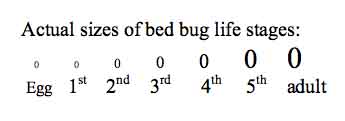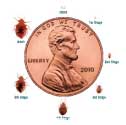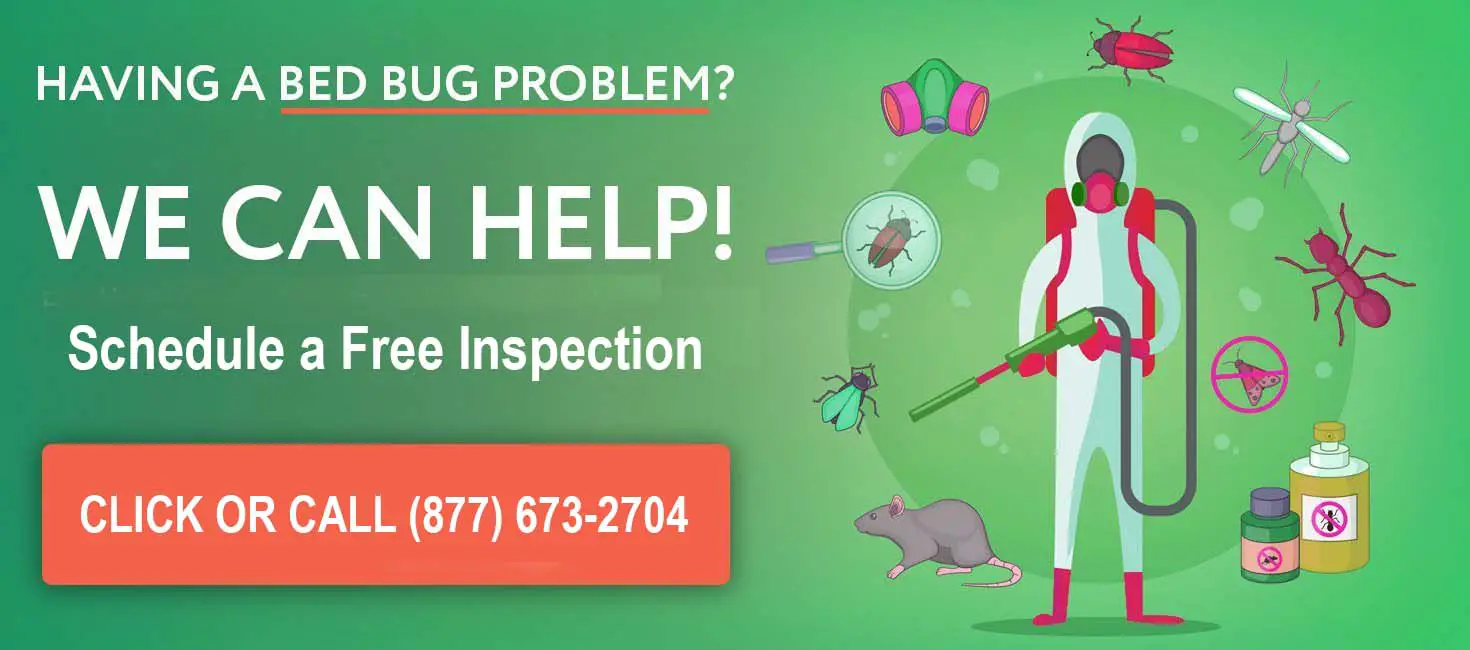Overview: What bed Bugs look like to the Naked eye
The following Bed Bugs pictures can help identify bugs in your home or apartment as well as any bites or symptoms on your body. Bed bugs at all stages can be seen with the naked eye. When they hatch the insects are small, so a magnifying glass and flashlight can aid in the inspection process.
Bed bugs have a flat, oval-round body shape and have 6 legs.
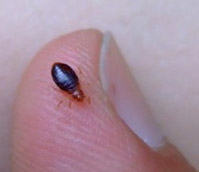 Bed Bug on Person's Thumb
Bed Bug on Person's ThumbWhen looking for bed bugs in the home, first realize that they follow a lifecycle. The insects start as an egg, move through infancy (called being an Instar or nymph), followed by adulthood (see life cycle chart below and National Geographic video).
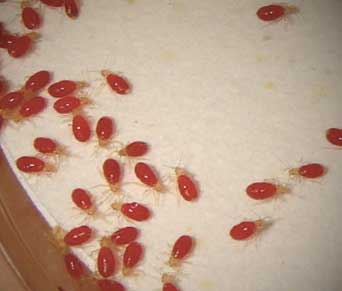 Pictures of Baby Bed Bugs
Pictures of Baby Bed BugsIn terms of skin reactions, it varies by person. Some people are not allergic to bed bug bites and will show no skin reaction. Others are highly allergic and will experience red skin bumps, irritation, and rash. Severe cases result in rashes. See pictures below for examples.
Bed bugs live for approximately 10 months and move through a life cycle from egg to adult. Infestations usually start with a female bed bug who would bite the host for blood upon arrival in the bed, and then for another "meal 2 weeks later.
At that point, she would lay eggs in the home at a rate of 3 per day. It takes 2 weeks for an egg to hatch. The just born nymph looks for food right away and becomes an adult bed bug in 4 months. The speed of reproduction and total life span is affected by room temperature and what is described assumes a room at 68F (20C).
The adult bed bug lives for approximately 10-months, but can live without feeding up to a year if you decide to move to another room. A typical infestation has between 4 and 500 bed bugs.
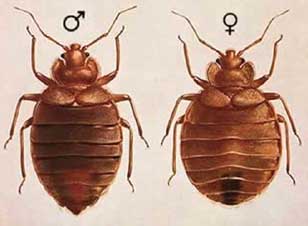 Female (left) and Male (right) Adult Bed Bugs. Males are oval shaped. Females have a more pronounced oval shape. After a blood meal appearance differences disappear.
Female (left) and Male (right) Adult Bed Bugs. Males are oval shaped. Females have a more pronounced oval shape. After a blood meal appearance differences disappear.Physical Appearance for Identification
|
Color: |
Adults: Bright red after feeding, dull red if haven't fed. Baby bed bug (nymph) straw, yellow color |
|
Size: |
1/5" to 1/4", eggs 1/32" |
|
Shape: |
Oval with a flattened body. Antennae, small eyes. |
Bed Bugs Lifecycle
Types of Bed Bugs Pictures
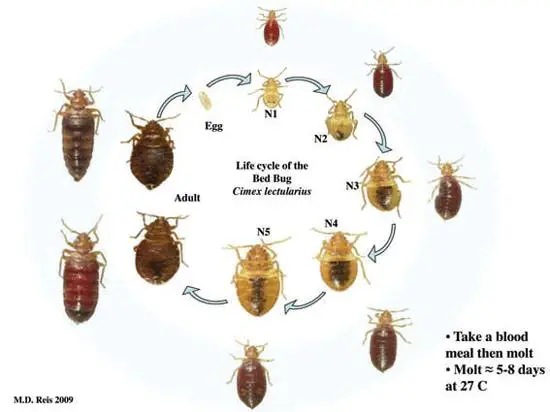 Bed Bug Lifecycle. Note how each bed bugs image changes as they move from stage to stage.
Bed Bug Lifecycle. Note how each bed bugs image changes as they move from stage to stage.Bed bugs move through 5 developmental stages before they become an adult. They must eat a blood meal before they move from stage to stage. The insects shed their exoskeleton between each stage. It takes 37 days for a bed bug to move from egg to adult in ideal temperatures which is greater than 72 degrees Fahrenheit.. An adult will live for about 1 year and for only 70 days if living without food. They can live longer in colder temperatures without a meal.
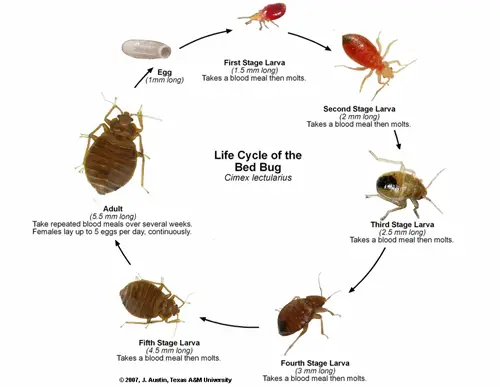 Bed bugs images at each lifestage. To lay eggs and grow, bedbugs need a blood meal. They hatch in 10 days and become adults in 2 to 4 months. (Texas A&M)
Bed bugs images at each lifestage. To lay eggs and grow, bedbugs need a blood meal. They hatch in 10 days and become adults in 2 to 4 months. (Texas A&M)How do you get rid of bed bugs?
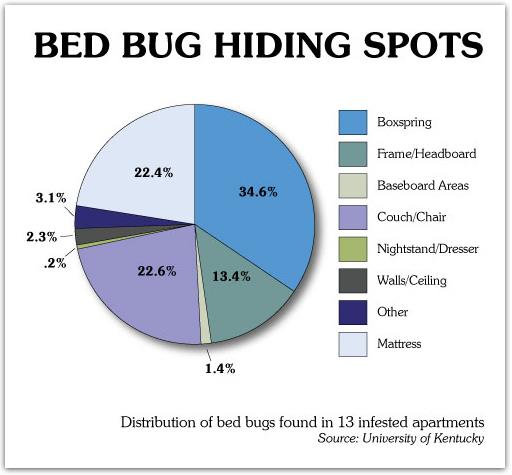
There are two ways to get rid of bed bugs, do it yourself, or our recommended method, which is to call an exterminator.
Why an exterminator? Bed bugs are the hardest insect to eliminate, even for a pro. They require up to 3 treatments to eliminate an infestation. A good place to start is with a call to a national network such as Home Advisor that can certify the skills of a local exterminator (or call 866-214-8380).
If you are going to "do it yourself", the best way to remove an infestation is to buy a kit which contains a collection of products and zippered covers needed to
- kill the bugs that you can see
- kill the bugs you can't
- protect against eggs you miss.
Good reasonably prices choices and kits are offered by Bed Bug Supply. More than one type of spray is needed to kill bedbugs, which is why a kit is essential.
If your mattress is over eight years old and showing signs of wear you may consider replacing it. See our guide for detailed instructions on pest control for eliminating bed bugs.
Bedbug Video
National Geographic Bed Bugs Video
An army of bed bugs can attack a person 500 times in one night! See these insects in action.
Adult bed Bugs Pictures
As this picture of a bed bug shows, adult bed bugs are approximately 1/4 inch to 3/8 inches long. After feeding on blood, the bug becomes a color that is a dull dark red. When the bugs are just born they have no color or look like a straw color.
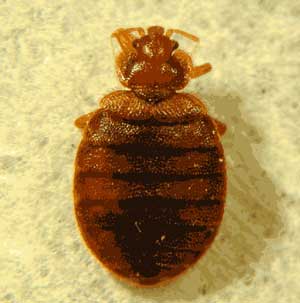 Magnified View of Bed Bug
Magnified View of Bed BugWhat Do Bed Bugs Look Like?
Bed bug photo - Flat view
 The Flat Profile Enables Bedbugs to Hide in Narrow Cracks
The Flat Profile Enables Bedbugs to Hide in Narrow CracksSide View
 Bed Bug Side View
Bed Bug Side ViewUniversity of Florida
Picture of Bed Bug on Skin
A bed bug only feeds on the skin for up to 10 minutes. One bug may make multiple bites. Each bed bug will feed every few days and then move back to their hiding place until they need to feed again as this picture of bed bugs shows.
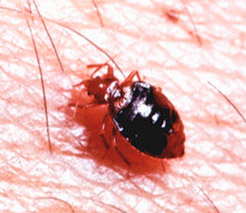 Bed Bug Photo on Skin
Bed Bug Photo on SkinBed Bugs Images - Engorged and not Engorged
In this picture, the bed bug on the left hasn't fed on a host yet. The bedbug on the right is engorged with blood.
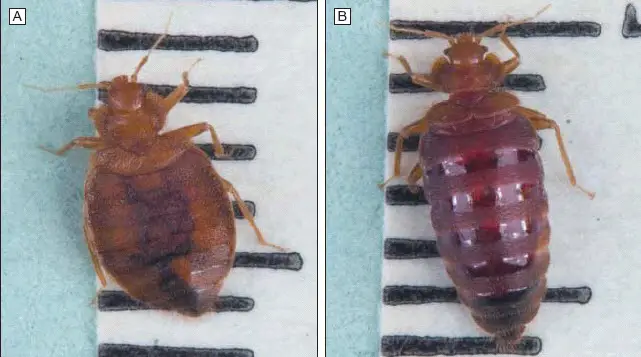 Engorged with Blood After Feeding on Host (left-A) and Not Engorged (Right-B) Bed Bugs Pictures
Engorged with Blood After Feeding on Host (left-A) and Not Engorged (Right-B) Bed Bugs PicturesBed bugs furniture photos
Bed bugs tend to hide near the bed, with 80% - 85% of any infestation found near the mattress or bed frame. However, they can also hide in nearby furniture, particularly if they were dropped in the area.
Couch
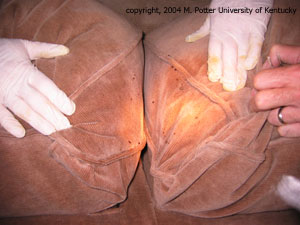 Bed Bugs on Surface of Couch
Bed Bugs on Surface of CouchUniversity of Kentucky
Furniture Fabric
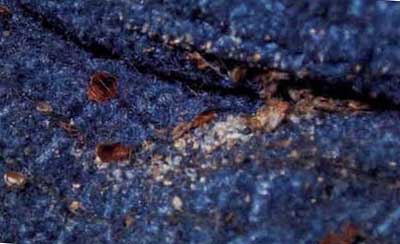 Bed Bugs Picture Showing Eggs, and Insects Hidden on Couch
Bed Bugs Picture Showing Eggs, and Insects Hidden on CouchChair
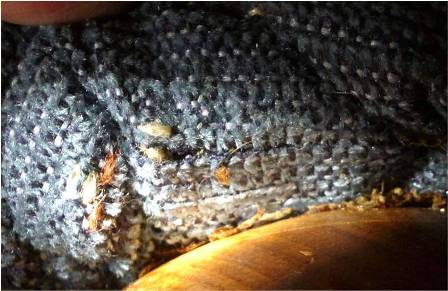 Bed Bugs on Chair Fabric
Bed Bugs on Chair FabricBed bugs mattress pictures
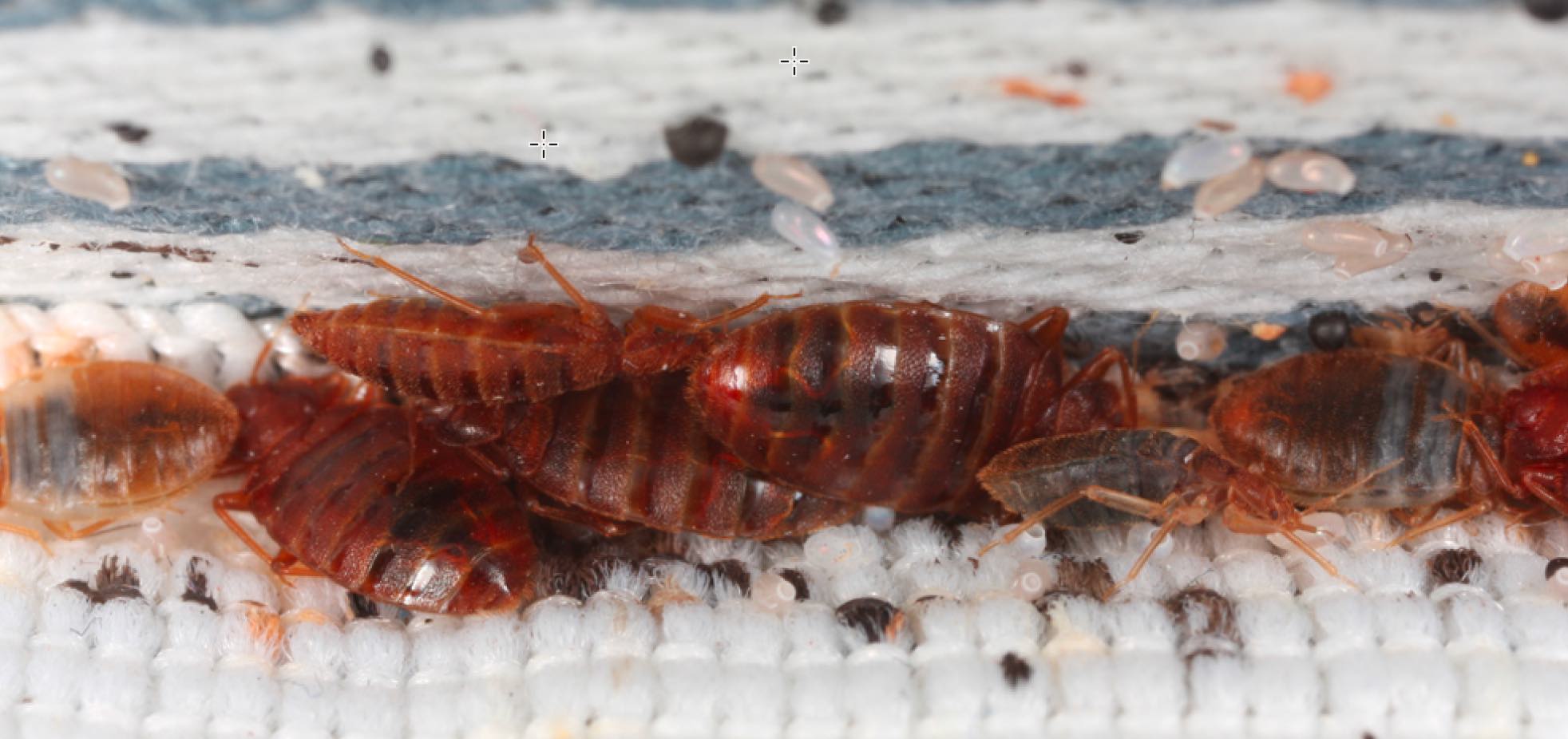 Magnified View of Bed Bugs Hiding in Mattress Seam
Magnified View of Bed Bugs Hiding in Mattress SeamBed bugs usually climb up bed legs or a headboard. They are attracted to the carbon dioxide exhaled by humans when breathing. Hiding spaces such as mattress seams are convenient ways to stay close to a human source for their next blood meal.
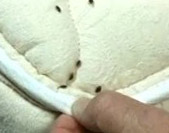 Pictures of Bed Bugs On Mattress (Actual Size)
Pictures of Bed Bugs On Mattress (Actual Size)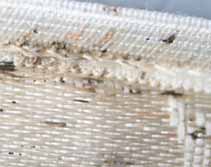 Picture of Bed Bug Fecal Smears and Blood Stains on Mattress
Picture of Bed Bug Fecal Smears and Blood Stains on Mattress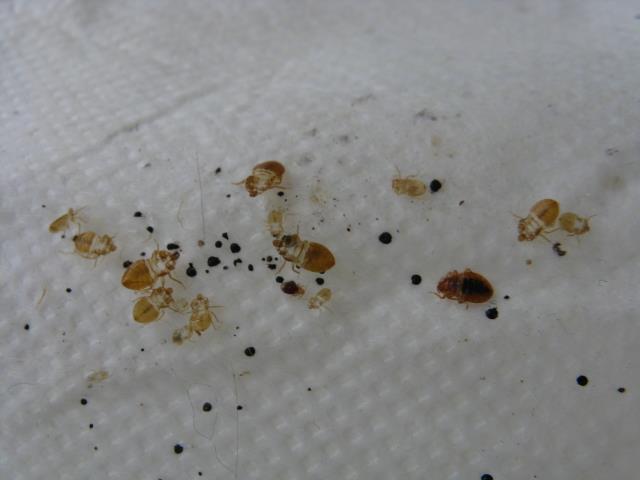 Pics of bed bugs molted skins on the mattress surface. One way to confirm an active bed bug infestation is to identify actual bed bugs on a mattress
Pics of bed bugs molted skins on the mattress surface. One way to confirm an active bed bug infestation is to identify actual bed bugs on a mattressPicture of Bed Bug eggs on furniture including adult bed bugs and just born bedbug (nymph). Each bed bug (females) will lay approximately 3 to 8 eggs and up to 500 eggs over their 10-month life. Each egg is 1/25 inch and is curved. The common bed bug will lay eggs in a sticky cluster. A bug will feed 24 hours after being hatched. Eggs will hatch between 4 and 12 days.
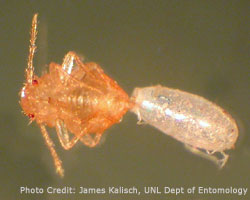 Bed Bug Hatching from Egg (UNL)
Bed Bug Hatching from Egg (UNL)Egg Shells
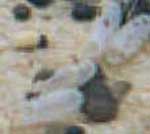 Bed Bug Eggs and Shells
Bed Bug Eggs and ShellsBed Bug Bite Pictures
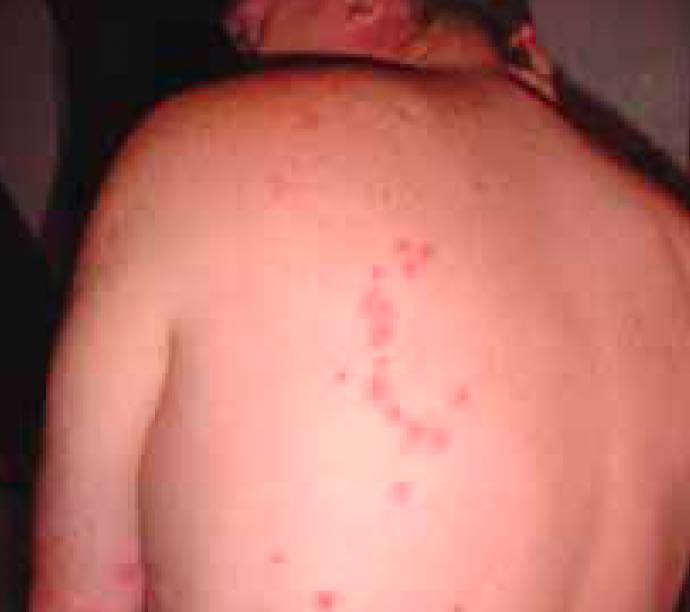 Multiple Bed Bug Bites Often Form a Linear Pattern
Multiple Bed Bug Bites Often Form a Linear Pattern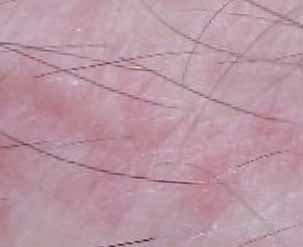 This Picture of Bed Bug Bites Results in a Skin Rash 30 Mintutes After Bite. Skin Reactions Can Appear Up to 24 Hours After Being Bitten Usually Lasts for 1 to 2 Days.
This Picture of Bed Bug Bites Results in a Skin Rash 30 Mintutes After Bite. Skin Reactions Can Appear Up to 24 Hours After Being Bitten Usually Lasts for 1 to 2 Days.While bed bugs will bite anyone, they only leave red, irritated skin reactions on people that are allergic to the bites. This is why two people sleeping in the same bed can experience no symptoms after getting several bedbug bites, or only one of the two people will see symptoms.
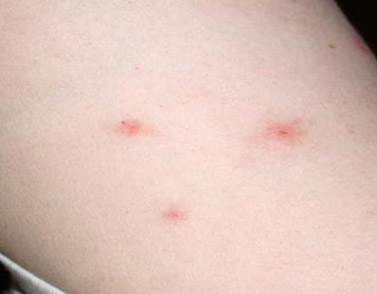 Picture of Bed Bug Bite
Picture of Bed Bug BiteNot sure if you have a bed bug problem?
Not sure you have a bed bug infestation? Trouble evaluating your
problem based on these bed
bugs pictures. One good way to evaluate a
bed bug is to complete this form and send to the Cornell Diagnostic Lab,
with a sample bug for evaluation. See this page for more bed
bug photos or here for more bed
bug pictures.
Remember that each bed bugs picture will be different from being a baby
bed bug or nymph through adulthood.
Call a bed bug exterminator
Bed
bugs are difficult to exterminate. It's preferable to call in an expert
who can confirm the presence of bed bugs, knows how to conduct a proper
inspection, and who uses specialized equipment to treat the problem.
The bugs multiply quickly so be sure to act as soon as you
think
you have a problem.
Start by either getting a free quote from a reputable company like Home Advisor (call 877-673-2704 or check our list for a local bed bug exterminator near you. Only
use
companies and representatives of those companies that have specific
expertise in treating bed bugs.
questions and Answers
Ask a Question or Share Your Bed Bug Experience With Others
Do you have a question or great story about bed bugs? Share it!
What Other Visitors Have Said About Bed Bugs
Click below to see contributions from other visitors to this page...
Eliminating Bed Bugs Yourself 




Reader Question: I am on disability with VERY limited resources. Is it possible for me to eliminate a bed bug problem myself?
Do I have bed bugs? 




I received a brand new Sunbeam electric blanket for Christmas. When I laid it on my bed I found a dead adult bed bug in the center of it. I immediately …
Bed bugs can and DO cause mental stress as well as physical! 




I've been living in an "extended living" building for two and a half years now. Bed bugs have been a part of our lives the whole time. I suffer from …
Do I have bed bugs? 




Well a few days ago I had these strange red marks on my arm. Just this morning I had a couple more bumps. I've checked the bed, but I haven't found anything...even …
Heat Kills Bed Bugs! 




I'm a US service member stationed in Germany. I've lived here several years without problems. My wife and two children started getting bites all over, …
Bed Bugs are without any doubt the worst kind of home invasion that... 




Bed Bugs are without any doubt the worst kind of home invasion that is possible. I woke up last Sunday thinking I had hives from strawberries, then I remembered …
Have Bed Bugs But No Bites 



When my husband and I first moved into our appartment we were sleeping on two twins beds. Now I am 4'10" and my husband is 6'2". And this bed was not working …
Bedbugs Have Taken Over! Please HELP!!!! Not rated yet
OMG! I have bedbugs now it's terrible. I have a low-income and am struggling. I have destroyed my bed and I have bombed and sprayed these little suckers. …
Hotel Bed Bugs Nightmare!!! Not rated yet
I stayed at a hotel last night...the banff trail hotel, cheap place but I woke to a feeling on my feet.
Here I had a bite on each foot and on my wrist. …
BED BUG HORRIA Not rated yet
I GOT BITTEN ALL OVER BY BED BUGS WHILE STAYING @ BELMONT INN IN METROPOLIS, IL FOR WEDDING. I BROUGHT THEM HOME IN ALL MY LUGGAGE AND CLOTHING. I HAVE …
Do Bed Bugs Have Hair on Their Body? Not rated yet
I have had a previous infestation and i think they are back for more.. i found one today and it has some long hairs attached to the end of there blood …
How to Bed Bugs Choose Where to Bite on the Body? Not rated yet
How Do they find a particular place on your body to feed on? Mine only got me behind my arms, nowhere else.
Editor Response to Where Do Bed Bugs Bite …
Egypt Bed Bugs Treatment Not rated yet
I live in Egypt and have resided in the same apartment for 35 years. We are used to mosquitoes and the dreaded cockroaches and have the flat professionally …
Bed bug paranoid Not rated yet
I just traveled to Vietnam and I discovered I stayed in a hotel with bed bugs. I've had the worst itching and hurtful bites ever, I have them all over …
Giant bed bug Not rated yet
These things were a living nightmare. This one was really big. Like a bedbug on steroids. No one believed me when I told them how big it was. This was …
Brochures
Free brochures for download with additional bed bugs pictures and information.
Learn More About Bed Bugs
Bed Bugs: Get Them Out and Keep Them Out (U.S. EPA)
Common Comprehensive Bed Bug Prevention Techniques
